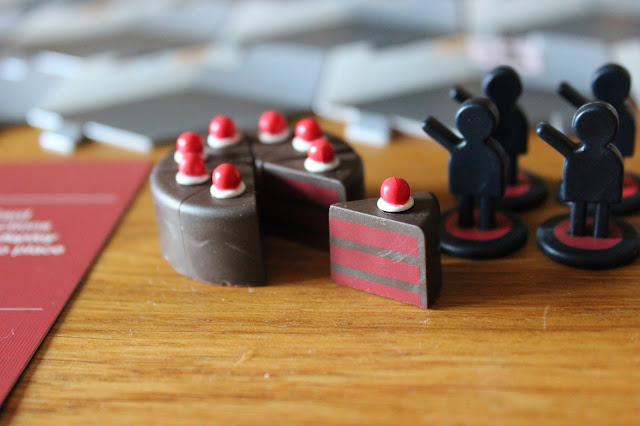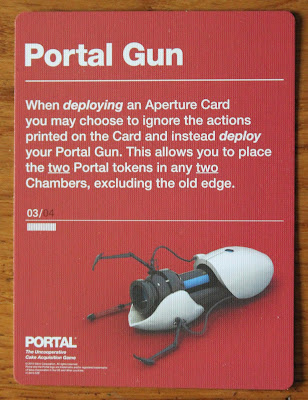(Okay, it's a bit cheesy and obvious, and sort of gives away what I think of the game before you've read the post, but I had to use the song lyrics in here somewhere!)
If you don't have a clue what I'm talking about, chances are you've not played the genius video game Portal, Valve's 2007 puzzle game set in the Half-Life universe. This means you've definitely missed out, and you really should try it. I don't think I can explain my enthusiasm for the board game version without a bit of Portal video game background first, so bear with me!
Waking up as a test subject in the dubious Aperture Science Enrichment Center, you (as silent protagonist Chell) are forced to complete numerous 'testing' scenarios by the definitely-not-suspicious facility AI, GLaDOS (Genetic Lifeform and Disk Operating System, if you wondered). Occasionally there is the promise of delicious cake.
Using the weapon provided you can shoot surfaces to create two different portals, one blue and one orange, which are linked. Stepping through one portal teleports you to the other, allowing you to move through the test chamber and solve puzzles, which could involve activating buttons or switches, avoiding traps or moving objects. Momentum is conserved when you hop through the portal, so placing one end at the bottom of a pit and one in the wall behind you, say, would mean that when you jump down into the pit you'll shoot out of the wall and across the pit, thus bypassing the obstacle.
The concept is, as with most good puzzles, staggeringly simple, often difficult and huge amounts of fun.
My love for the game was compounded by the release of 2011 sequel Portal 2. Fleshing out the original concept of the first game, this time there was more story, more passive-aggressive commentary from GLaDOS and a potentially-marriage-wrecking co-op mode. As important to me as the gameplay though, is the sense of humour present throughout the world of Aperture Science. It's as clever and dark as the game's design is eye-catching and iconic.
And now there is a board game. 'How can this possibly work?' says my head, upon hearing this. 'Shut up and take my money!' says everything else. Guess which won?
Designed in association with Valve, Portal: The Uncooperative Cake Acquisition Game was published in October by Cryptozoic Entertainment. If they hadn't had me at 'Portal' I would definitely have caved at 'cake', so purchase was inevitable.
The aim of the game is to have the most cake (always a good thing to strive for) when all of one 'team' of test subjects has been destroyed (not so good!)
Portal's game board (or Aperture Laboratories) comprises 15 interlocking hexagonal 'test chamber' tiles arranged into three rows of five. Each turn, one chamber is activated and then 'recycled' by GLaDOS, moving it from the 'old' end of the board (on the right) to the 'new' end (on the left) and destroying any unfortunate test subjects therein. This causes your remaining little test subjects to be shuffled from their starting point at the new end towards their inevitable destruction, conveyor belt style.
The only way to obtain the required cake is to receive it as a reward for testing - the player with the majority of test subjects in a chamber when it gets 'activated' earns the reward printed on that tile. This is how you gain slices of cake, additional test subjects, Aperture cards or use of the Companion Cube and Turret pieces.
Aperture cards give you various power-up advantages in the game. Cleverly, you have to be careful about which ones you use and what order you use them in, because on the back of each card is a Character with some additional rule text. Whichever Character card shows at the top of the discard pile modifies the rules for all players until it's hidden by a new card.
You can also use Aperture cards to 'power up' your Portal Gun - this allows you to discard an Aperture card (ignoring the text) to position the orange and blue portal tokens in two chambers. These two chambers are then considered adjacent for movement purposes.
Any cake that you receive as a reward arrives at the new end of the lab and begins the same conveyor belt shuffle as everything else. Since test subjects can carry cake as they move, you can use them to try and keep your precious baked goods close to the new end of the lab. However, your opponents can also run off with it, like so:
Since any cake in an activated chamber ends up in the incinerator, it is in everyone else's interest to steal your cake and convey it to its fiery doom at the old end of the lab. If all of one player's cake gets incinerated, it's game over.
Once you have more cake than everyone else in play in the lab, it's time to start planning how to take out all of one player's test subjects and end the game. It took me a while (and bitter, bitter defeat) to figure out that this could include *your own test subjects*! It's tough to find the right balance between getting enough test subjects in play to win rewards from activated chambers and having few enough that you can easily kill them off when you have the 'cake advantage'.
The game does a brilliant job of evoking the Aperture atmosphere and uses elements from the video game without trying too hard to replicate it directly. The experience loses a little something for non-Portal-fans, but I think they can still have a lot of fun with the gameplay and only end up missing some visual references in the theme. For instance, me: 'Eee, it's the Companion Cube! Cuuute!' - non-Portal person: 'what does this box do again?'.
Luckily cake has universal appeal, as does a well-designed game, and the straightforward nature of the turn sequence really lets you focus on the puzzle and have fun, even if you don't know who Wheatley is or own your own talking Turret...
Picking on some negatives, linking the cardboard tiles can be a bit fiddly - especially when you run out of room for your conveyor belt and have to scoot the whole arrangement along the table - but it's still a really clever mechanic.
Also, poor GLaDOS only gets a cameo appearance, really - you're supposed to use her little cardboard standee to mark which chamber you're going to activate before you recycle it, but the time this takes is so small that there's not much point moving her. Mostly she just sits by the board and glares at everyone.
Tightly-cut tiles notwithstanding, the rest of the game is beautifully made with the theme applied to great effect throughout. The Companion Cube and Turret miniatures are great and the other plastic components are really nicely made.
The slightly-beaten-up '70s aesthetic of the box really fits in with the Aperture Laboratories world and I love it. Even the manual continues to add to the theme, with nicely written rules, helpful tips and clarification for every point of contention that's come up for us so far.
If you're a Portal fan, you need to play this game. It even comes with a free Steam key for Portal 2 in the box that you can give to your friends, so that they can love Portal too!
Since I already own it, I thought I'd give my Steam activation key away - and if you already own it maybe you can give it to a friend and try out the co-op mode! You can enter the giveaway using the Gleam widget below.
Portal 2 Steam Key Giveaway
Terms and conditions
- One prize available, a Portal 2 (PC/Mac/Linux) Steam activation code, to be chosen using Gleam and announced on this page.
- The giveaway will close at midnight on Tuesday 15th December 2015.
- The winner will be contacted by e-mail within 3 days of the end of the giveaway. If they do not respond within 14 days another winner may be chosen.
- Entries using any software or automated process to make bulk entries will be disqualified.
















